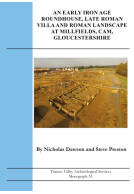Archaeological excavations at Latton Quarry, Wiltshire (Paperback)
Imprint: Thames Valley Archaeological Services
Series: TVAS Monograph Series
Pages: 158
ISBN: 9781911228011
Published: 6th May 2016
Script Academic & Professional
Series: TVAS Monograph Series
Pages: 158
ISBN: 9781911228011
Published: 6th May 2016
Script Academic & Professional
Usually available in 6-8 weeks.
You'll be £17.00 closer to your next £10.00 credit when you purchase Archaeological excavations at Latton Quarry, Wiltshire. What's this?
+£4.99 UK Delivery or free UK delivery if order is over £40
(click here for international delivery rates)
Order within the next 4 hours, 54 minutes to get your order processed the next working day!
Need a currency converter? Check XE.com for live rates
(click here for international delivery rates)
Order within the next 4 hours, 54 minutes to get your order processed the next working day!
Need a currency converter? Check XE.com for live rates
This report documents the archaeological examination of a large (18ha) parcel of land which was formerly a Scheduled Monument, and lies adjacent to a large cropmark enclosure complex. The fieldwork investigated a wide range of deposits, with early Neolithic, middle Bronze Age, early and middle Iron Age and early Anglo-Saxon occupation being revealed, along with Iron Age, Roman and Medieval land division. The early Neolithic is represented by just two pits. The middle Bronze Age is represented by an enclosure, which is infrequently recorded for this period in this region. The early Iron Age occupation consists of dispersed settlement including groups of post-built roundhouses. The middle Iron Age is represented by a single ring gully roundhouse, a typical form for the region, which may be on the edge of a larger settlement to the south.
Occupation then ceased and the site appears to have been used only as farmland, with just a few middle to late Roman boundary ditches, producing very little pottery. This continued until early Anglo-Saxon occupation in the form of a post-built hall, with a second activity focus represented by an unusual dispersed group of pits. The Anglo-Saxon occupation is notable in that it dates from a time and place at the limits of Anglo-Saxon expansion along the Upper Thames Valley in what was still a frontier zone.
Other titles in the series...
Other titles in Thames Valley Archaeological Services...










